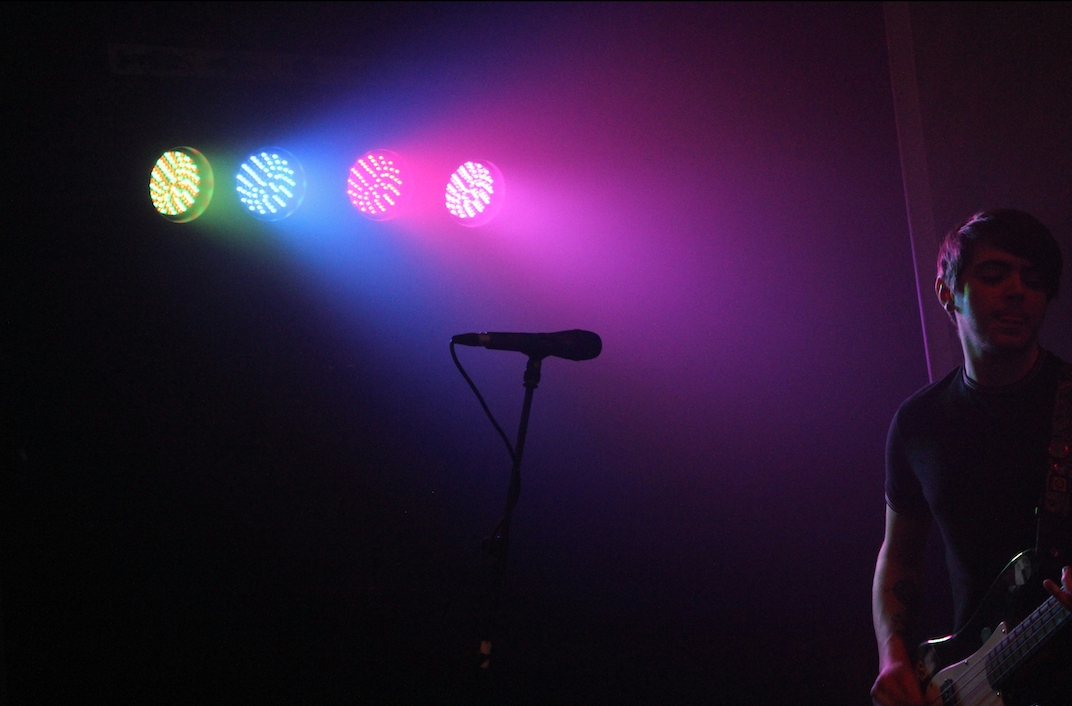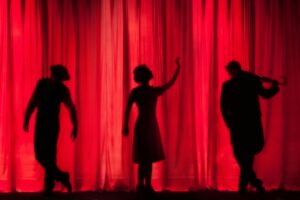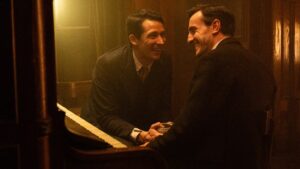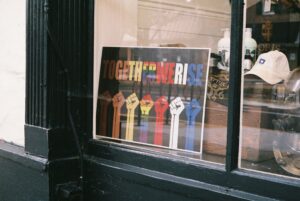Having aired its first episode in October of 1975, Saturday Night Live wrapped up its fiftieth season this past May. Throughout the years, SNL has seen many hosts, guests, and artists. It’s tried to keep things lighthearted amongst the ups and downs of the last 50 years, including nine presidencies and three major wars. SNL sketches reflect the political climate of their time period. When it comes to the way Americans have perceived LGBTQ+ people since 1975, there is perhaps no evidence more unique than that of a sketch comedy show.
However, SNL is, after all, a business – one that aims to stay profitable. While the show has employed LGBTQ+ people over the years, its outward support of the community has never been consistent. Pick any sketch from any season, and you’ll find a mirror of the cultural climate in which it aired. What we as a society deem funny – what gets laughs, what gets cut, and who gets to be in on the joke – is always a reflection of our collective values. Looking back at SNL through a queer lens isn’t just about who was there; it’s about who was allowed to be seen, and on what terms.
1975-1979: Queer beginnings
Queerness has been around since the very beginning of SNL, whether that queerness was public knowledge or not. The very first show of the first season featured queer musician Janis Ian. She, like several LGBTQ+ people who made appearances around this time, wasn’t out at the time. On episode six of the same season, Lily Tomlin became the first LGBTQ+ host. She then came back to host again when season two featured both her and a young Jodie Foster.
1980-1984: Denny Dillon
The beginning of the 1980s saw the first LGBTQ+ SNL employees who sadly only stayed for a short time. Earliest documented is Denny Dillon, who appeared in the show’s sixth season from 1980 to 1981. Reportedly out to colleagues but not executives, Dillon survived a turbulent season with her friend, fellow cast member Gail Matthius.
In the series “SNL Stories from the Show”, Dillon highlights her sketch Waxmans in SoHo in which Debbie Harry, playing her niece, comes out to her. The Washington Post quotes Dillon saying, “[T]he word ‘lesbian’ was literally a punch line in lots of scripts [at the time].” Waxmans in SoHo seems to stand out to her fondly, as well as The Leather Weather Report, which she says attracted much gay fan mail. She was the shortest tenured SNL cast member. Both Dillon and Matthius were axed during a change in producers as part of an effort to improve the show after cast member Charles Rocket swore on air in February 1981.
1985: Danitra Vance and Terry Sweeney
In 1985, Danitra Vance joined SNL as the show’s first Black woman cast member. Though not publicly out, many knew about her sexuality. In a sketch by the gay theater troupe Hot Peaches, she played a “career lesbian” in 1-800-LESBIAN. Fellow cast member Terry Sweeney once asked her about coming out:
“She’d be like: ‘Listen, Terry, I’m Black, I’m a woman, I’m from the projects. I don’t need one more thing they can use against me.”
Vance reportedly bristled at being handed stereotypical sketches about Black women.
After Vance left, Sweeney became SNL’s first out cast member – and the first openly gay person on network television. Having come out in 1973, Sweeney refused to sign NBC’s morality clause banning anyone who was “a criminal, a convict, or a homosexual.” Even after SNL creator Lorne Michaels vouched for him, Sweeney noticed his scripts were smaller. Michaels told him not to be discouraged and to “write your own stuff.”
Behind the scenes, Sweeney also endured homophobia from Chevy Chase, who pitched a sketch where Sweeney would play a man with AIDS “who gets weighed every week on the show.”
Still, Sweeney was proud of the gay content that made it to air: a gay Cat on a Hot Tin Roof-inspired sketch, one with Madonna mocking AIDS panic, and frequently appearing in drag as Nancy Reagan. His partner, Lanier Laney, was also a writer on the show.
Sweeney recalls unexpected fan mail: “I’d get letters that said, ‘My parents hate gay people, but they love you,’… That part, I’m proud of.” That reflects the “But Not Too Gay” trope – queer people being seen as palatable only when they avoid same-sex attraction and make people laugh. During the AIDS crisis, that felt like progress. But looking back from 2025, “we hate your people, but love you” doesn’t feel like a compliment.
After Sweeney left in the 1990s, SNL had no out queer cast members until Kate McKinnon in 2012.
1990s: Mickey the Dyke
The 1990s were a tough time for queer people, and SNL was no different. First appearing in 1995, Cheri Oteri’s character Mickey the Dyke fully revolved around the character’s sexuality. It’s true that not all of the jokes were mean-spirited. However, this sketch came when “dyke” was already a popular anti-gay slur, and this didn’t help discourage its use. Some lesbians reclaimed the word for themselves, but the recurring character may have done more harm than good. The Christmastime episode in which Mickey comes out to her family includes this line read by Will Ferrell: “And so, Mickey the Dyke was loved and accepted by everyone. Even though as we all know it would just take a real man to turn her around.” Yikes.
1990s: LGBTQ representation on SNL
From 1995 to 2008, trans writer Harper Steele served as head writer, responsible for sketches like The Ladies Man and Give Up the Ham. Steele recently collaborated with Will Ferrell for the documentary Will and Harper, during which the two process transition and friendship.
In the 1990s, prolific LGBTQ writers Paula Pell and James Anderson also joined SNL as writers. They wrote many iconic sketches, such as 2001’s ahead-of-its-time Homocil parody sketch. This was a commercial promoting a drug for parents upset by their gay children: “Because it’s your problem, not theirs.”
Until he retired in 2020, Anderson wrote many queer sketches including Liza Minnelli Tries To Turn Off A Lamp and GP Yass. Pell, who became the first lesbian head writer in 2006, is responsible for characters like Debbie Downer, Justin Timberlake’s Omeletteville, and the Spartan Cheerleaders. She also went on to write for 30 Rock, Bridesmaids, and This Is 40.
1990s: It’s Pat
1990s SNL was home to the heavy-hitter It’s Pat. This character, featured in over ten sketches, first debuted in late 1990. The whole joke was people trying to guess the gender of Julia Sweeney’s character Pat. For many, it was humiliating to watch. In 2017, “Transparent” creator Jill Solloway called the sketch a “hateful, awful thing to do to nonbinary people.”
Sweeney defended the character, saying she understood the criticism, but that the character “isn’t trans or non binary.” She stated that Pat inspired a lot of trans writers in L.A. While that may be true, Sweeney said the sketches aimed to make fun of “people… not being able to handle the fact that they couldn’t tell.” If, over two decades later, there’s enough confusion from viewers – whether straight people laughing at Pat or queer people feeling bad about themselves –perhaps it didn’t land quite right. Pat also went on to star in their own movie, which bombed at the box office.
1990s: Stereotypes die hard
In 1991, Chris Farley and Adam Sandler appeared in the sketch Schmitt’s Gay, parodying hyper-sexualized women in beer commercials. This type of sketch may land with the LGBTQ+ community because the joke isn’t made at their expense. These guys are just happy to see hot people regardless of gender. As The Advocate put it, “it’s nice to see Chris Farley and Adam Sandler play these gay characters just like they would any other characters (as dumb, horny bros).”
Interestingly, Schmitt’s Gay writer Robert Smigel also created a recurring animated sketch called The Ambiguously Gay Duo. This first aired in 1996 and ended in 2011. Aimed at parodying homoerotic superhero pairings such as Batman and Robin, this sketch featured countless innuendos. It reduced gay superheroes, and gay men in general, to a one-note stereotype.
These characters didn’t really have any other distinct characteristics that lent themselves to storytelling. One gay critic, Adrian Margaret Brune, after watching the latest installment of Ambiguously Gay Duo wrote that “somewhere, out there in the great expanse of our country, a young gay man took note of how not to act, how not to appear gay, how not to live openly, lest he subject himself to the jokes that never seem to end, harmless or not.”
Similar to Julia Sweeney’s take on It’s Pat, Smigel claimed the sketches laughed at people intending to “out” the heroes. However, the laughs come specifically when the duo didn’t realize how gay their actions made them look.
1990s: From bad to worse
From the stereotypical lisp to the kitschy outfits, the Stuart Smalley character hit SNL as a walking, talking gay stereotype in 1991. The whole punchline in this Al Franken sketch series is Smalley being gay, which made his dad an alcoholic. Then, apparently, it’s funny that the dad beats him and his mom, and he’s “too feminine to stop the assault.”
Lastly, the ‘90s featured Canteen Boy Goes Camping, a sketch that SNL has removed from their YouTube channel. This Adam Sandler sketch was particularly tone deaf, making light of pedophilia and associating it with gay men. Fortunately, things start looking up from here, though that is admittedly a very low bar.
2000s: We’re getting somewhere… Maybe
2000s SNL marked an improvement upon the chaotic 1990s. In the year 2000, in Season 25, Alan Cumming became the first out LGBTQ+ host. Unfortunately, it’s difficult to find footage of his episode, and they reportedly did not give him much to work with.
In 2001, Gay Hitler debuted, featuring Chris Kattan, Tina Fey, and Jimmy Fallon. This sketch focuses on the theory that Hitler was gay, and jokes that he titled his autobiography Mein Boyfriend. It also features the catchphrase “Sprechen Sie dick?” which went on to be used in Step Brothers.
From 2001-2002, Rachel Dratch starred as the Girl With No Gaydar who tells herself gay men are into her. This relies on stereotypes, tying into the “Gay Best Friend” trope that was gaining popularity at the time. It doesn’t seem super offensive, since the joke was more about her being obtuse, but it isn’t very imaginative, either. The queer sketches that followed in the subsequent years were more promising.
Mid-2000s: Stefon
In 2008, Bill Hader debuted Stefon on SNL, perhaps his most popular character. For the most part it was very well-received. Some noted that he continued to use the word “midget” long after the word was considered offensive. Although Stefon was a stereotypical depiction of a queer man, the character did serve another purpose: recommending over-the-top, outrageous-sounding nightclubs.
Also, the character does end up marrying his crush, Weekend Update host Seth Meyers, who objects during Stefon’s wedding with Anderson Cooper. Perhaps the most charming and redeeming part of Stefon was how much fun Bill Hader clearly has doing it.
2010s: A queer SNL is born
In 2011, Chris Kelly joined SNL as the first gay man to be a head writer. The show subsequently earned acclaim and Emmy nominations with him and Sarah Schneider at the helm. During this period they also hired queer writer Julio Torres, responsible for the 2016 sketch Wells for Boys, a parody commercial for non-gendered toys that give sensitive boys a safe space.
In 2012, out lesbian Kate McKinnon joined the cast. Until she left in 2022, she gathered an impressive repertoire of celebrity impressions, including Elizabeth Warren, Hillary Clinton, Rudy Giulani, Ruth Bader Ginsberg, and more. She also starred in many noteworthy sketches, including Long Island Medium (2012) and Whiskers R We (2016).
In 2014, Kate McKinnon and Aidy Bryant starred in Dyke and Fats, written by Chris Kelly and Sarah Schneider. In this sketch, the titular characters tell Louis C.K.’s character he can’t say “dyke and fats.” They say “You don’t get to call us that!” and “Those are our words!”
This calls out the idea that only those who have had a slur used against them can reclaim it. It’s the cherry on top that they got to deliver it to Louis C.K.
2015-2019: Totino’s and Sara Lee
Over time, SNL has added more and more queer writers. It’s not unusual to watch a queer sketch and correctly deduce that queer people were behind it. Often, these sketches poke fun while being respectful. We saw this with Totino’s With Kristen Stewart, written by Chris Kelly and Sarah Schneider in 2017, and Sara Lee, written by Julio Torres and Bowen Yang in 2019.
Both sketches include queer sexuality in ways that are situational. Vanessa Bayer and Kristen Stewart falling in love is funny because they have a kissing-in-the-rain montage a few feet away from Bayer’s “hungry guys” in the living room. Them being into each other isn’t the joke, nor are there any gay innuendos. This kind of sketch helps normalize queerness in that the humor here is about something else entirely.
Similarly, the humor in Sara Lee doesn’t come from Harry Styles’s character being gay and sliding into male celebrities’ DMs. It’s funny because of its youthful slang and juxtaposition of sexuality with an innocuous brand of bread products. It also helps that the people in these sketches are either part of the community or allies: Kristen Stewart came out on SNL on the Totino’s episode, declaring that she’s “so gay.” Harry Styles, known for his gender-fluid fashion, has a long track record of supporting the LGBTQ+ community.
The importance of queer writers
It’s special to see comedy from people with different backgrounds. The more diverse the writers’ room is, the more range the content will have. For example, Bowen Yang, who became a writer in 2017 and a cast member in 2019, breathes life into the show by bringing the new (to SNL) perspective of a queer Asian man. This allows room for more people to present their takes on current events, which in turn encourages open-mindedness from audiences. It can also help queer viewers feel like they are heard and seen.
We can all learn something from people of different sexualities, genders, and ethnicities taking the stage. We can understand what they find funny, what affects them, what is important to them, and we can question our own preconceived notions.
2020s: Queer SNL glory days
This current decade has provided fresh, funny, and diverse sketches. Notably, 2023’s We’re Trying, written by queer writers, riffs on queer people co-opting bizarre straight phrases. Refusing to explain how they’re having a baby, Adam Driver and Bowen Yang deliver deadpan lines like, “God, this is so invasive. People think they can just ask gay people anything.” This sketch unites all sexualities coming together to laugh at themselves and poke fun at sexualized language that’s totally acceptable from one group of people and not another.
Lesbian Period Drama (2021) is another example of laughing with – not at – queer people. It punches up, not down, subverting the overdone “sad lesbian movie” trope while fostering community through shared recognition. The joke isn’t “no more sad lesbian films”, but rather a push for more variety in queer storytelling.
2023’s Straight Male Friend, written by Streeter Seidell, Bowen Yang, and Alex English, also leans into queer humor. It follows a gay man, exhausted by emotionally intense straight female friends, who finds relief in a straight male friend who doesn’t talk feelings or even know his last name. It stays light while nudging straight men to self-reflect.
Alex English, a queer Black writer who joined in 2021, contributed to standout sketches like Hot Girl Hospital and Lisa From Temecula. The latter starred Punkie Johnson – SNL’s first queer Black woman cast member since Danitra Vance in 1985 – and became one of Season 48’s top five most-watched sketches. English said working at SNL was fun but challenging: the show still has a long way to go in terms of Black representation, especially with showing queer Black voices. “You have to dance a little harder,” he said.
2020s: Struggling, but with humor
2021 introduced two other queer-written sketches, It Gets Better and Pride Month Song. Bowen Yang discussed writing the latter sketch with queer writers Sudi Green and Celeste Yim in a Pride Source interview. Here he also stated, “You think [Pride] is gonna be this amazing thing and it actually ends up being really stressful and logistically a nightmare and someone has a meltdown at some point.” This is the importance of queer writers: they understand struggles that are inherently queer, providing a more nuanced portrayal. Acknowledging Pride Month as not just a celebration but a source of stress is very relatable, especially since the pandemic.
In 2022, Molley Kearney, the first openly non-binary SNL cast member, comedically soared down from the rafters during the Weekend Update to deliver an important message about trans rights. “For some reason, there’s something about the word ‘trans’ that makes people forget the word ‘kids,’” Kearney said. “If you don’t care about trans kids’ lives, it means you don’t care about freakin’ kids’ lives.”
They combined a sincere message with humor, descending in a harness to deliver a joke about being “hung up on genitals.” Although Kearney has left SNL, hopefully these moments continue and prove you can be funny and deliver a genuine message.
Hosts without the most: Dave Chapelle
Throughout the years, SNL has seemed to want it both ways: appealing to conservatives and liberals alike. This was clear in bizarre choices such as mocking Sarah Palin and then inviting her on the show, Trump-backing Republican Nikki Haley popping up during Ayo Edibiri’s opening monologue, and asking Shane Gillis back to host in 2024 after firing him for racist and homophobic comments in 2019.
Other hosts have also proven unsavory. Dave Chapelle has hosted the show four times. During the dress rehearsal for one of them, he reportedly made a joke about SNL writer Celeste Yim’s they/them pronouns. This occurred in 2022, a year after he made jokes at the expense of trans people. This included a piece in his Netflix special “The Closer” where he says, “I’m Team TERF.”
He then hosted SNL again in January 2025, where during a record-breaking 17-minute monologue, he said he was “tired of being controversial.” He also wished Trump would “do better next time”, and then reminded the audience at large to do better next time. But being tired of being controversial isn’t an apology, and hoping everyone does better when the “everyone” includes someone who wields more power than the majority of people ever will? It doesn’t seem fair, to say the least.
Hosts without the most: Trump and Musk
Trump hosted the show twice, most recently in 2015 as a presidential hopeful. By that point, he had a long history of racism and had most recently called Mexicans rapists, made disparaging remarks about John McCain’s military record, and had enough of a repertoire of past sexist comments for Republican debate moderator Megyn Kelly to ask him about it, to which he replied with another sexist comment. After Trump won the election in 2016, SNL cast members felt ashamed and believed the show contributed to his success.
Elon Musk hosted SNL in 2021 and spent all his sketches playing various iterations of a creepy man. He hosted the show while people already knew him for mocking personal pronouns, spreading COVID-19 misinformation, and undermining the SEC. On SNL, when he wasn’t trying to smooth over his image, he was making cast members cry. Musk’s hosting garnered many angry reactions, but in the end it was just a lukewarm episode. According to the Hollywood Reporter, the hosting was “more forgettable than controversial”, and the biggest compliment they could give was that he “wasn’t Donald Trump.”
Whether or not SNL continues to select problematic hosts as a means of seeking ratings, it’s troubling that they’ve already stepped foot on this dangerous path. It allows a view of dictatorship and fascism that is much too casual. Singer and R&B artist Miguel put it succinctly: “There’s a responsibility we have to have, and I don’t think ignorance deserves that kind of attention.” The right already dismisses SNL as liberal lies, anyway.
Rethinking who gets to be funny on SNL
Hopefully, SNL continues to stick to nuanced portrayals of all identities as opposed to relying on stereotypes. Those with marginalized identities may play on stereotypes of themselves, but this often has a much different vibe. When a marginalized person jokes about their own community, they often bring nuance and authenticity rather than mean-spiritedness. It comes from a place of understanding.
Current LGBTQ+ cast members such as Jimmie Fowlie and Celeste Yim say they feel the love and are grateful for the path paved for them, noting that the atmosphere is “loving.” It’s a common story: older generations struggle to get us on the road, and then further generations keep the car running smoothly. Of course, we need to perform tune-ups every now and then.
2025: Cross-cultural comedy
The push for more diversity continues. At the moment, SNL is introducing more Spanish language content than ever before, made popular by Marcello Hernandez’s sketches. Because he’s currently the only cast member who can write in Spanish, Hernandez – similar to Terry Sweeney providing the gay perspective in the 1980s – pens Spanish-speaking roles for himself.
He also wrote the sketches Protective Mom, Protective Mom 2, Telenovela, and Spanish Class for Spanish-speaking guest hosts Pedro Pascal, Ana de Armas, and Bad Bunny. Especially for his sketches with Bad Bunny, the majority of the dialogue is in Spanish. SNL has featured Spanish sketches before, ranging from inaccuracy in the 1980s to making references to Latin culture in the 2000s and steering away from too much Spanish so as not to offend a non-Spanish-speaking audience.
Hernandez has countless more sketches in which he speaks Spanish, making him the first person to bring back Spanish sketches since Fred Armisen left in 2013. With the success of newer SNL cast members like Bowen Yang, Ego Nwodim, Punkie Johnson, and the first Arab cast member, Emil Wakim, it seems like the sketch series may be entering a new era.
Check out:
Uncertain Futures: The LGBTQIA+ Community’s Continuous Battle for Equal Rights







Be First to Comment